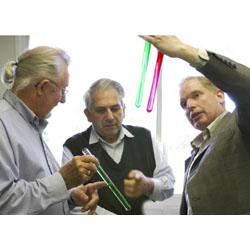Queensland's 'Smart State' embraces sunshine
Published on 01 August, 2003
The Queensland Government’s move to the new ‘Smart State’ image has not been at the expense of sunshine.
The Government is backing chemistry researchers at Central Queensland University (CQU) to develop plastic solar cells, which one day could be on the number plates which carry the Smart State motto.
 The State Minister for Public Works, Robert Schwarten MP, has recognized the potential of reducing vehicle emissions through the use of solar cells on the Queensland Government transport fleet (QFleet). He has taken the initiative to develop a partnership in solar cell research between QFleet and CQU with a grant of $312,000 to help develop the technology, which could make solar power more viable for its vehicles.
The State Minister for Public Works, Robert Schwarten MP, has recognized the potential of reducing vehicle emissions through the use of solar cells on the Queensland Government transport fleet (QFleet). He has taken the initiative to develop a partnership in solar cell research between QFleet and CQU with a grant of $312,000 to help develop the technology, which could make solar power more viable for its vehicles.
Plastic solar cells contain dye-type substances able to harvest light (in a manner similar to photosynthesis in plants) and turn the resulting stimulus into electrons. Like plants, plastic solar cells could function effectively without direct sunlight, using low-level natural or artificial lighting.
Researchers at CQU's Centre for Molecular Architecture (CMA), in collaboration with nanomaterials researchers at Massey University in New Zealand, are learning how to make the process efficient enough to be viable for commercial applications.
The same technology would have hundreds of other applications, since cheap plastic solar cells could be applied in flexible sheets to windows, clothing, household appliances or even painted onto roofs.
Building on the early support of the Australian Research Council, this new initiative provides a great springboard to fast track the goal of developing a commercial product in the next decade.
Caption: CMA’s Professor Ron Warrener (left) and Professor Doug Butler (centre) are collaborating with Professor David Officer of Massey University on the project.

